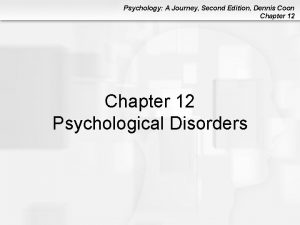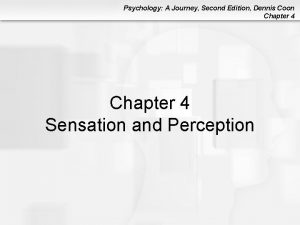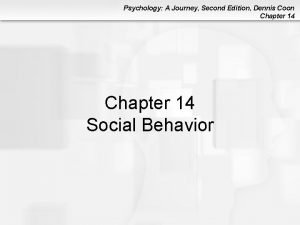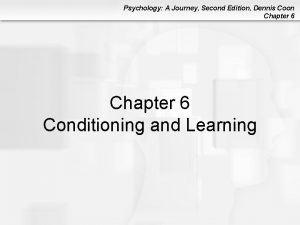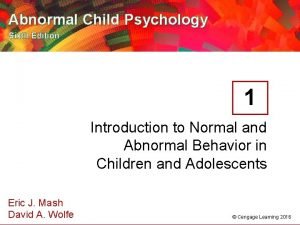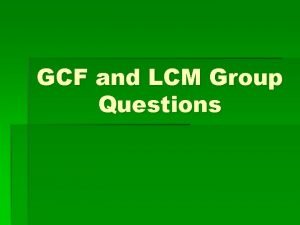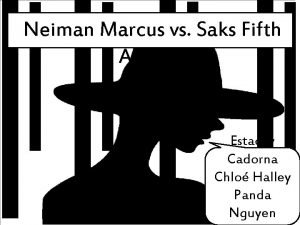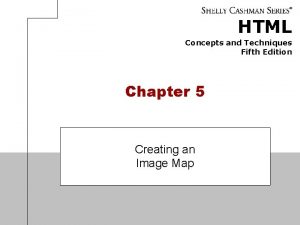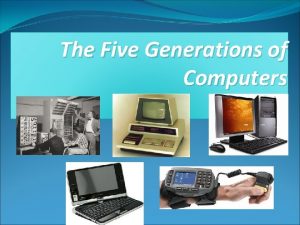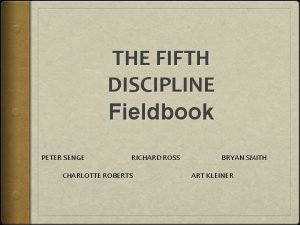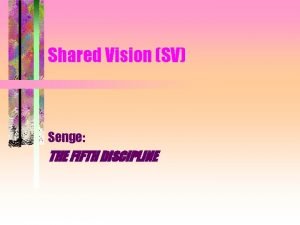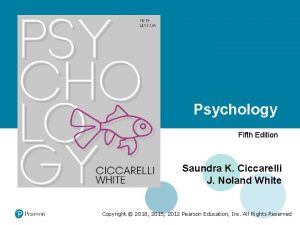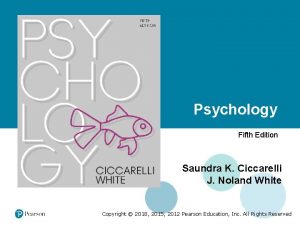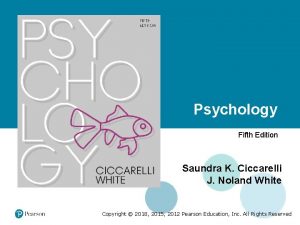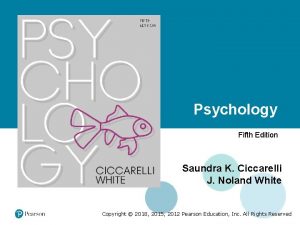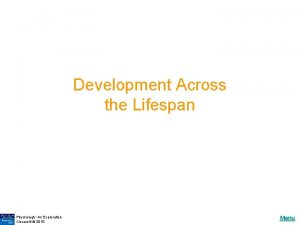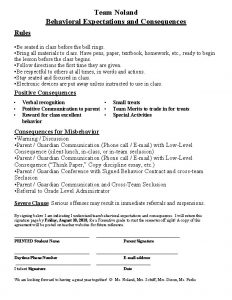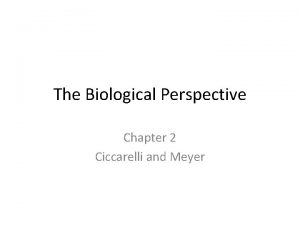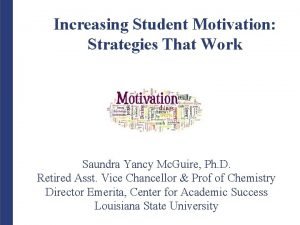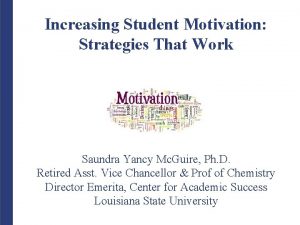Psychology Fifth Edition Saundra K Ciccarelli J Noland





















































- Slides: 53

Psychology Fifth Edition Saundra K. Ciccarelli J. Noland White Copyright © 2018, 2015, 2012 Pearson Education, Inc. All Rights Reserved

Psychology Fifth Edition 12 Chapter 12 Social Psychology

Learning Objectives 1 of 2 12. 1 Identify factors that influence people or groups to conform to the actions of others. 12. 2 Explain how our behavior is impacted by the presence of others. 12. 3 Compare and contrast three compliance techniques. 12. 4 Identify factors that make obedience more likely. 12. 5 Identify the three components of an attitude and how attitudes are formed. 12. 6 Describe how attitudes can be changed. 12. 7 Explain how people react when attitudes differ from behavior. 12. 8 Describe how people form impressions of others.

Learning Objectives 2 of 2 12. 9 Describe the process of explaining one’s own behavior and the behavior of others. 12. 10 Distinguish between prejudice and discrimination. 12. 11 Describe theories of how prejudice is learned and how it can be overcome. 12 Identify factors involved in interpersonal attraction. 12. 13 Describe the different types of love outlined in Sternberg’s theory. 12. 14 Explain how aggressive behavior is determined by biology and learning. 12. 15 Identify the factors influencing why people help others. 12. 16 Define social neuroscience.

Conformity 1 of 2 Learning Objective 12. 1 Identify factors that influence people or groups to conform to the actions of others. • Social psychology: the scientific study of how a person’s behavior, thoughts, and feelings influence and are influenced by social groups – Includes the social world in which we exist, as we are surrounded by others to whom we are connected and by whom we are influenced in so many ways

Conformity 2 of 2 • Social influence: the process through which the real or implied presence of others can directly or indirectly influence thoughts, feelings, and behavior of an individual • Conformity: changing one’s own behavior to match that of other people

Figure 12. 1 Stimuli Used in Asch’s Study Participants in Asch’s famous study on conformity were first shown the standard line. They were then shown the three comparison lines and asked to determine to which of the three was the standard line most similar. Which line would you pick? What if you were one of several people, and everyone who answered ahead of you chose line 3? How would that affect your answer? Source: Adapted from Asch (1956).

Group Behavior 1 of 4 Learning Objective 12. 2 Explain how our behavior is impacted by the presence of others. • Groupthink: occurs when people place more importance on maintaining group cohesiveness than on assessing the facts of the problem with which the group is concerned

Table 12. 1 Characteristics of Groupthink Characteristic Description Invulnerability Members feel they cannot fail. Rationalization Members explain away warning signs and help each other rationalize their decision. Lack of Introspection Members do not examine the ethical implications of their decisions because they believe that they cannot make immoral choices. Stereotyping Members stereotype their enemies as weak, stupid, or unreasonable. Pressure Members pressure each other not to question the prevailing opinion. Lack of disagreement Members do not express opinions that differ from the group consensus. Self-deception Members share in the illusion that they all agree with the decision. Insularity Members prevent the group from hearing disruptive but potentially useful information from people who are outside the group. Source: Janis (1972, 1982). Blank cell

Group Behavior 2 of 4 • Group polarization: members involved in a group discussion tend to take somewhat more extreme positions and suggest riskier actions when compared to individuals who have not participated in a group discussion

Group Behavior 3 of 4 • Social facilitation: positive influence of others on performance • Social impairment: negative influence of others on performance – Social loafing: people who are lazy tend not to do as well when others are also working on same task – Cultural assumptions

Group Behavior 4 of 4 • Deindividuation: a lessening of one’s sense of personal identity and personal responsibility – Groups or crowds can offer a sense of anonymity – Stanford prison experiment

Compliance 1 of 2 Learning Objective 12. 3 Compare and contrast three compliance techniques. • Compliance: changing one’s behavior as a result of other people directing or asking for the change • Consumer psychology: branch of psychology that studies the habits of consumers in the marketplace, including compliance

Compliance 2 of 2 Learning Objective 12. 2 Ways to Gain Compliance • Foot-in-the-door technique: asking for a small commitment and, after gaining compliance, asking for a bigger commitment • Door-in-the-face technique: asking for a large commitment and then, after being refused, asking for a smaller commitment • Lowball technique: getting a commitment from a person and then raising the cost of that commitment

Obedience Learning Objective 12. 4 Identify factors that make obedience more likely. • Obedience: changing one’s behavior at the command of an authority figure • Milgram’s shocking research: “teacher” administered what he or she thought were real shocks to a “learner” – Participants consistently follow orders to administer apparently painful shocks – Raised ethical questions about how far researchers should be willing to go

Figure 12. 2 Control Panel in Milgram’s Experiment In Stanley Milgram’s classic study on obedience, the participants were presented with a control panel like this one. Each participant (“teacher”) was instructed to give electric shocks to another person (the “learner, ” who only pretended to be shocked). At what point do you think you would have refused to continue the experiment?

Table 12. 2 Sample Script Similar to Those in Milgram’s Classic Experiment Voltage of “Shock” Learner’s Script 120 “Ouch! Experimenter, let me out of here, I’m through! Please, I have heart trouble, I don’t want to go on. ” 150 “That’s it, enough! I will not be part of this experiment, let me out now!” 300 (Scream of pain heard in the background) ”I am not doing this anymore, you can’t make me stay here. Get me out, get me out!” 330 (Louder and longer scream of pain) ”Get me out, get me out, my heart! My chest hurts, get me out of here, let me out of here, you have no right to do this! Let me out of here!” Blank cell Source: Milgram (1964 a, 1974).

Social Cognition • Social cognition - the mental processes that people use to make sense of the social world around them. – How we perceive others – First impressions – How we explain behavior of others and ourselves

Attitudes 1 of 3 Learning Objective 12. 5 Identify the three components of an attitude and how attitudes are formed. • Attitude: a tendency to respond positively or negatively toward a certain person, object, idea, or situation • Three components of an attitude: 1. Affective (emotional) component 2. Behavioral component 3. Cognitive component

Figure 12. 3 Three Components of an Attitudes consist of the way a person feels and thinks about something, as well as the way the person chooses to behave. If you like country music, you are also likely to think that country music is good music. You are also more likely to listen to this style of music, buy this type of music, and even go to a performance. Each of the three components influences the other two.

Attitudes 2 of 3 • Attitudes are often poor predictors of behavior unless the attitude is very specific or very strong

Attitudes 3 of 3 • Attitude Formation – – Direct contact with the person, situation, object, or idea Direct instruction from parents or others Interacting with other people who hold a certain attitude Vicarious conditioning: watching the actions and reactions of others to ideas, people, objects, and situations

Attitude Change: The Art of Persuasion 1 of 2 Learning Objective 12. 6 Describe how attitudes can be changed. • Persuasion: the process by which one person tries to change the belief, opinion, position, or course of action of another person through argument, pleading, or explanation – Key elements in persuasion are source of the message, the message itself, the target audience, and the medium

Attitude Change: The Art of Persuasion 2 of 2 • Elaboration Likelihood Model – People will either elaborate on the persuasive message or fail to elaborate on it – Future actions of those who do elaborate are more predictable than those who do not – Central-route processing: involves attending to the content of the message itself – Peripheral-route processing: involves attending to factors not involved in the message, such as the expertise of the source of the message, the length of the message, and other non-content factors

Cognitive Dissonance: When Attitudes and Behavior Clash Learning Objective 12. 7 Explain how people react when attitudes differ from behavior. • Cognitive dissonance: sense of discomfort or distress that occurs when a person’s behavior does not correspond to that person’s impression – Lessened by changing the conflicting behavior, changing the conflicting attitude, or forming a new attitude to justify the behavior

Figure 12. 4 Cognitive Dissonance: Attitude Toward a Task After completing a boring task, some participants were paid $1 and some $20 to convince others waiting to do the same task that the task was interesting and fun. Surprisingly, the participants who were paid only $1 seemed to change their own attitude toward the task, rating it as interesting, whereas those who were paid $20 rated the task no differently than a control group did. SOURCE: Adapted from Festinger and Carlsmith (1959).

Impression Formation 1 of 3 Learning Objective 12. 8 Describe how people form impressions of others. • Impression formation: forming of the first knowledge a person has about another person – Primacy effect: the very first impression one has about a person tends to persist even in the face of evidence to the contrary

Impression Formation 2 of 3 • Social categorization: the assignment of a person one has just met to a category based on characteristics the new person has in common with other people with whom one has had experience in the past – Stereotype: a set of characteristics that people believe is shared by all members of a particular social category

Impression Formation 3 of 3 • Implicit personality theory: sets of assumptions about how different types of people, personality traits, and actions are related to each other – Implicit Association Test (IAT): measures the degree of association between concepts • Schemas: mental patterns that represent what a person believes about certain types of people – Schemas can become stereotypes

Attribution 1 of 3 Learning Objective 12. 9 Describe the process of explaining one’s own behavior and the behavior of others. • Attribution: the process of explaining one’s own behavior and the behavior of others • Attribution theory: theory of how people make attributions

Attribution 2 of 3 • Situational cause: cause of behavior attributed to external factors – Delays – Action of others – Some other aspect of the situation • Dispositional cause: cause of behavior attributed to internal factors – Personality – Character

Attribution 3 of 3 • Fundamental attribution error (actor-observer bias): the tendency to overestimate the influence of internal factors in determining behavior while underestimating situational factors – Cross-cultural differences in attribution – Age as factor in attribution – Motive as factor in attribution

Prejudice and Discrimination 1 of 3 Learning Objective 12. 10 Distinguish between prejudice and discrimination. • Prejudice: negative attitude held by a person about the members of a particular social group • Discrimination: treating people differently because of prejudice toward the social group to which they belong

Prejudice and Discrimination 2 of 3 • Forms of prejudice include ageism, sexism, racism, and prejudice against those who are too fat or too thin • In-groups: social groups with whom a person identifies; “us” • Out-groups: social groups with whom a person does not identify; “them”

Prejudice and Discrimination 3 of 3 • Scapegoating: tendency to direct prejudice and discrimination at out-group members who have little social power or influence

How People Learn and Overcome Prejudice 1 of 5 Learning Objective 12. 11 Describe theories of how prejudice is learned and how it can be overcome. • Social cognitive theory: views prejudice as an attitude acquired through direct instruction, modeling, and other social influences • Realistic conflict theory: conflict between groups increases prejudice and discrimination

How People Learn and Overcome Prejudice 2 of 5 • Social identity theory: the formation of a person’s identity within a particular social group is explained by social categorization, social identity, and social comparison – Social identity: the part of self-concept including one’s view of self as a member of a particular social category – Social comparison: the comparison of oneself to others in ways that raise one’s self-esteem

How People Learn and Overcome Prejudice 3 of 5 • Stereotype vulnerability: the effect that people’s awareness of the stereotypes associated with their social group has on their behavior • Self-fulfilling prophecy: the tendency of one’s expectations to affect one’s behavior in such a way as to make the expectation more likely to occur

How People Learn and Overcome Prejudice 4 of 5 • Education and intergroup contact • Equal status contact: contact between groups in which the groups have equal status, with neither group having power over the other – Robber’s Cave study

How People Learn and Overcome Prejudice 5 of 5 • “Jigsaw classroom”: educational technique in which each individual is given only part of the information needed to solve a problem, forcing individuals to work together to find the solution

Interpersonal Attraction Learning Objective 12. 12 Identify factors involved in interpersonal attraction. • Interpersonal attraction: liking or having the desire for a relationship with another person – Physical attractiveness – Proximity: physical or geographical nearness – Birds of a feather: people like people who are similar to themselves ▪ Complementarity is another aspect of this – Reciprocity of liking: tendency of people to like other people who like them in return

Love Is a Triangle: Robert Sternberg’s Triangular Theory of Love 1 of 2 Learning Objective 12. 13 Describe the different types of love outlined in Sternberg’s theory. • Love: a strong affection for another person due to kinship, personal ties, sexual attraction, admiration, or common interests • Sternberg’s three components of love: 1. Intimacy 2. Passion 3. Commitment

Love Is a Triangle: Robert Sternberg’s Triangular Theory of Love 2 of 2 • Romantic love: consists of intimacy and passion • Companionate love: consists of intimacy and commitment • Consummate love: ideal love, in which all three components are present

Aggression 1 of 3 Learning Objective 12. 14 Explain how aggressive behavior is determined by biology and learning. • Aggression: behavior intended to hurt or destroy another person • Frustration–aggression hypothesis: aggression is a reaction to frustration • Konrad Lorenz saw aggression as an instinct for fighting to promote the survival of our species

Aggression 2 of 3 • Biological influences on aggression may include genetics, the amygdala and limbic system, and testosterone and serotonin levels – Alcohol has impact on aggression

Aggression 3 of 3 • Social role: the pattern of behavior that is expected of a person who is in a particular social position – Violent TV, movies, and video games also related to aggression

Prosocial Behavior 1 of 4 Learning Objective 12. 15 Identify the factors influencing why people help others. • Prosocial behavior: socially desirable behavior that benefits others • Altruism: prosocial behavior that is done with no expectation of reward and may involve the risk of harm to oneself – Temporoparietal junction (TPJ) is larger in individuals who make altruistic choices

Prosocial Behavior 2 of 4 • Bystander effect: the effect that the presence of other people has on the decision to help or not help – Help becomes less likely as the number of bystanders increases – Case of Kitty Genovese

Figure 12. 5 Elements Involved in Bystander Response In a classic experiment, participants were filling out surveys as the room began to fill with smoke. As you can see in the accompanying graph, the time taken to report smoke and the percentage of people reporting smoke both depended on how many people were in the room at the time the smoke was observed. If a person was alone, he or she was far more likely to report the smoke and report it more quickly than when there were three people. Source: Latané & Darle (1969).

Prosocial Behavior 3 of 4 • Diffusion of responsibility: a person fails to take responsibility for action or for inaction because of the presence of other people who are seen to share the responsibility • Researchers Latané and Darley found that people who were alone were more likely to help in an emergency than people who were with others – One bystander cannot diffuse responsibility

Prosocial Behavior 4 of 4 • Five steps in making a decision to help 1. 2. 3. 4. 5. Noticing Defining an emergency Taking responsibility Planning a course of action Taking action

Table 12. 3 Help or Don’t Help: Five Decision Points Decision Point Description Factors Influencing Decision Noticing Realizing that there is a situation that might be an emergency Hearing a loud crash or a cry for help. Defining an Emergency Interpreting the cues as signaling an emergency Loud crash if associated with a car accident, people are obviously hurt. Taking Responsibility Personally assuming the responsibility to act A single bystander is much more likely to act than when others are present (Latané & Darley. 1969. ) Planning a Course of Action Deciding how to help and what skills might be needed People who feel they have the necessary skills to help are more likely to help. Taking Action Actually helping Cost of helping (e. g. danger to self) must not outweigh the rewards of helping.

Peaking Inside the Social Brain Learning Objective 12. 16 Define social neuroscience. • Social neuroscience: the study of how biological processes influence social behavior – Studies use f. MRI and other imaging techniques to discover areas of the brain involved in social actions – TJP involved in prosocial behavior and competitive behavior
 Psychology fifth edition ciccarelli white
Psychology fifth edition ciccarelli white Saundra stock md
Saundra stock md Elastomeric impression materials examples
Elastomeric impression materials examples Castaway character
Castaway character Principles of marketing fifth european edition
Principles of marketing fifth european edition Molecular biology
Molecular biology Fundamentals of corporate finance fifth edition
Fundamentals of corporate finance fifth edition Human anatomy fifth edition
Human anatomy fifth edition Democritus atomic model diagram
Democritus atomic model diagram Human anatomy fifth edition
Human anatomy fifth edition Molecular biology of the cell
Molecular biology of the cell Stephanie ciccarelli
Stephanie ciccarelli Devco organigramme
Devco organigramme Gianni ciccarelli
Gianni ciccarelli Using mis 10th edition
Using mis 10th edition Using mis (10th edition) 10th edition
Using mis (10th edition) 10th edition Social psychology ninth edition
Social psychology ninth edition Psychology ninth edition in modules
Psychology ninth edition in modules Psychology a journey
Psychology a journey Reuptake psychology
Reuptake psychology Psychology a journey 4th edition chapter 1
Psychology a journey 4th edition chapter 1 Psychology ninth edition in modules
Psychology ninth edition in modules Psychology tenth edition david g myers
Psychology tenth edition david g myers Fundamentals of abnormal psychology ninth edition
Fundamentals of abnormal psychology ninth edition Psychology a journey 4th edition chapter 1
Psychology a journey 4th edition chapter 1 Psychology eighth edition david g myers
Psychology eighth edition david g myers Psychology ninth edition in modules
Psychology ninth edition in modules General adaptation syndrome
General adaptation syndrome Psychology a journey 4th edition chapter 1
Psychology a journey 4th edition chapter 1 Equifinality psychology
Equifinality psychology Pure psychology
Pure psychology Positive psychology ap psychology definition
Positive psychology ap psychology definition Social psychology is the scientific study of:
Social psychology is the scientific study of: Group polarization.
Group polarization. Health psychology definition ap psychology
Health psychology definition ap psychology Social psychology ap psychology
Social psychology ap psychology Hamlet 5 soliloquies
Hamlet 5 soliloquies You have diving lessons every fifth day
You have diving lessons every fifth day 160 5th avenue
160 5th avenue Neiman marcus saks fifth avenue
Neiman marcus saks fifth avenue Blessed are the merciful sermon
Blessed are the merciful sermon Paragraph 5 of the ffa creed
Paragraph 5 of the ffa creed Fifth chapter menu
Fifth chapter menu First korotkoff sound
First korotkoff sound Pain as the fifth vital sign
Pain as the fifth vital sign 5th generation of computer
5th generation of computer I am a gas with 8 protons and 8 neutrons
I am a gas with 8 protons and 8 neutrons Peter senge 1990 the fifth discipline
Peter senge 1990 the fifth discipline Fifth standard solar
Fifth standard solar Fifth discipline
Fifth discipline What is iot design methodology
What is iot design methodology Pasture sentence
Pasture sentence Fifth ward jr high
Fifth ward jr high Definition of arterial blood pressure
Definition of arterial blood pressure


















